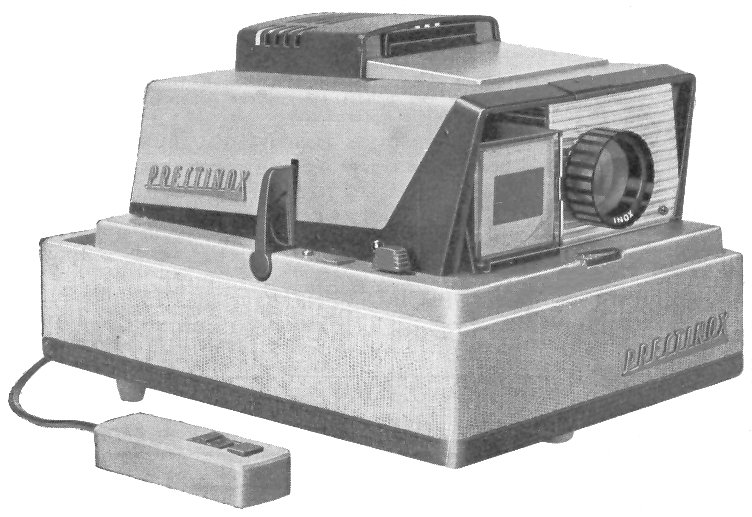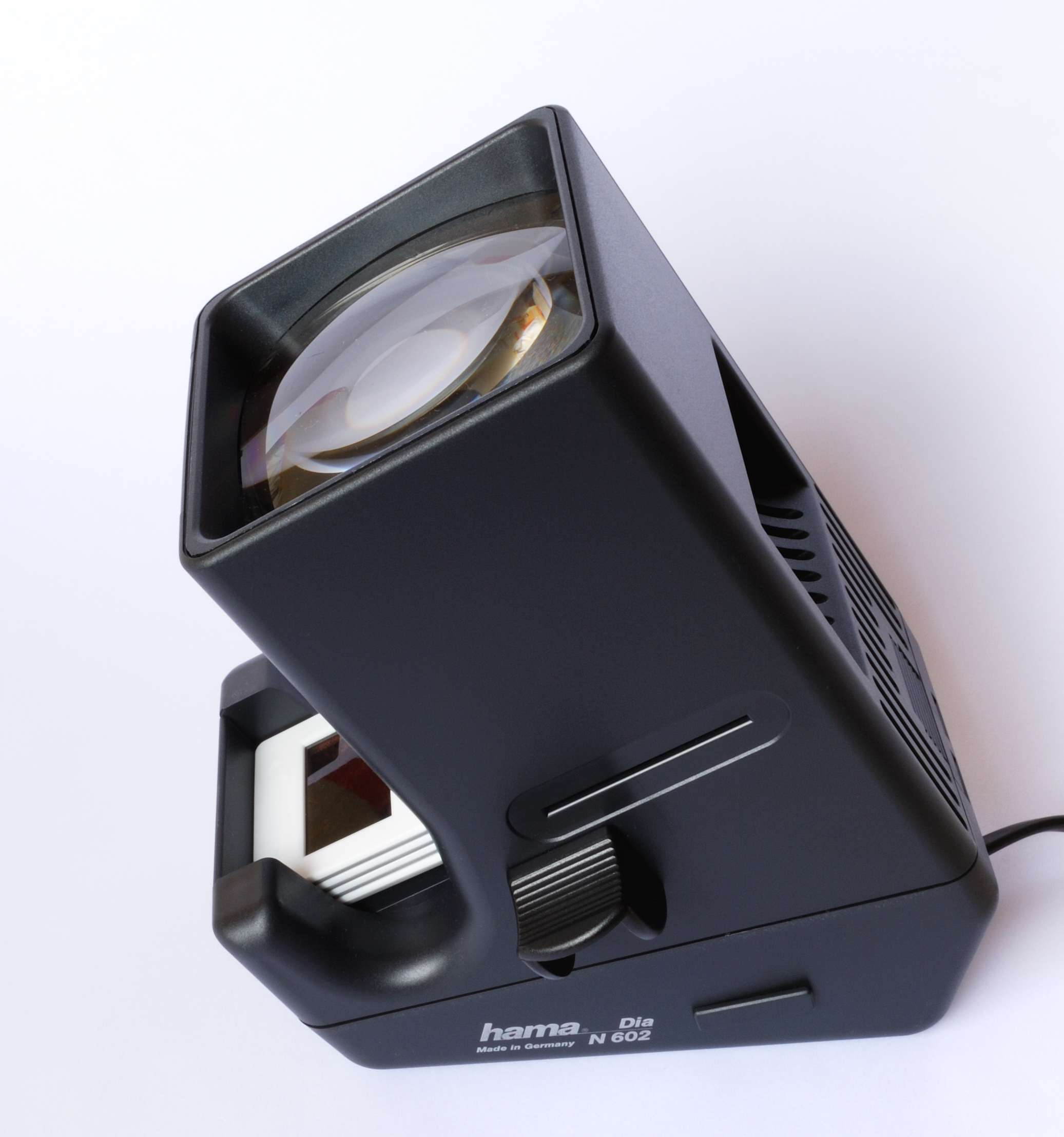|
Slide Projection
A slide projector is an opto-mechanical device for showing photographic slides. 35 mm slide projectors, direct descendants of the larger-format magic lantern, first came into widespread use during the 1950s as a form of occasional home entertainment; family members and friends would gather to view slide shows. Reversal film was much in use, and supplied slides snapped during vacations and at family events. Slide projectors were also widely used in educational and other institutional settings. Photographic film slides and projectors have mostly been replaced by image files on digital storage media shown on a projection screen by using a video projector or simply displayed on a large-screen video monitor. History A continuous-slide lantern was patented in 1881. It included a dissolving views apparatus.Sloane, T. O'Conor. ''Facts Worth Knowing Selected Mainly from the Scientific American for Household, Workshop, and Farm Embracing Practical and Useful Information ... [...More Info...] [...Related Items...] OR: [Wikipedia] [Google] [Baidu] |
Lens (optics)
A lens is a transmissive optical device which focuses or disperses a light beam by means of refraction. A simple lens consists of a single piece of transparent material, while a compound lens consists of several simple lenses (''elements''), usually arranged along a common axis. Lenses are made from materials such as glass or plastic, and are ground and polished or molded to a desired shape. A lens can focus light to form an image, unlike a prism, which refracts light without focusing. Devices that similarly focus or disperse waves and radiation other than visible light are also called lenses, such as microwave lenses, electron lenses, acoustic lenses, or explosive lenses. Lenses are used in various imaging devices like telescopes, binoculars and cameras. They are also used as visual aids in glasses to correct defects of vision such as myopia and hypermetropia. History The word ''lens'' comes from '' lēns'', the Latin name of the lentil (a seed of a lentil plant), ... [...More Info...] [...Related Items...] OR: [Wikipedia] [Google] [Baidu] |
Medium-format Slide Projector
Medium format has traditionally referred to a film format in photography and the related cameras and equipment that use film. Nowadays, the term applies to film and digital cameras that record images on media larger than the used in 35 mm photography (though not including 127 sizes), but smaller than (which is considered large format photography). In digital photography, medium format refers either to cameras adapted from medium-format film photography uses or to cameras making use of sensors larger than that of a 35 mm film frame. Some of the benefits of using medium-format digital cameras include higher resolution sensors, better low-light capabilities compared to a traditional 35mm DSLR, and a wider dynamic range. Characteristics Medium-format cameras made since the 1950s are generally less automated than smaller cameras made at the same time. For example, autofocus became available in consumer 35 mm cameras in 1977, but did not reach medium format until ... [...More Info...] [...Related Items...] OR: [Wikipedia] [Google] [Baidu] |
Polarization (waves)
Polarization (also polarisation) is a property applying to transverse waves that specifies the geometrical orientation of the oscillations. In a transverse wave, the direction of the oscillation is perpendicular to the direction of motion of the wave. A simple example of a polarized transverse wave is vibrations traveling along a taut string ''(see image)''; for example, in a musical instrument like a guitar string. Depending on how the string is plucked, the vibrations can be in a vertical direction, horizontal direction, or at any angle perpendicular to the string. In contrast, in longitudinal waves, such as sound waves in a liquid or gas, the displacement of the particles in the oscillation is always in the direction of propagation, so these waves do not exhibit polarization. Transverse waves that exhibit polarization include electromagnetic waves such as light and radio waves, gravitational waves, and transverse sound waves (shear waves) in solids. An electromagnetic wa ... [...More Info...] [...Related Items...] OR: [Wikipedia] [Google] [Baidu] |
Stereo Slide Projector
Stereophonic sound, or more commonly stereo, is a method of sound reproduction that recreates a multi-directional, 3-dimensional audible perspective. This is usually achieved by using two independent audio channels through a configuration of two loudspeakers (or stereo headphones) in such a way as to create the impression of sound heard from various directions, as in natural hearing. Because the multi-dimensional perspective is the crucial aspect, the term ''stereophonic'' also applies to systems with more than two channels or speakers such as quadraphonic and surround sound. Binaural sound systems are also ''stereophonic''. Stereo sound has been in common use since the 1970s in entertainment media such as broadcast radio, recorded music, television, video cameras, cinema, computer audio, and internet. Etymology The word ''stereophonic'' derives from the Greek (''stereós'', "firm, solid") + (''phōnḗ'', "sound, tone, voice") and it was coined in 1927 by Western E ... [...More Info...] [...Related Items...] OR: [Wikipedia] [Google] [Baidu] |
Slide Viewer
A slide viewer (also called transparency viewer) is a device for looking at film transparencies or similar photographic images. Description A slide viewer is usually a small handheld device with a slot in which a slide can be inserted to see a magnified illuminated view of it. A slide viewer is an instrument for individual viewing. Some models have an automatic feeder for inserting multiple slides and some have a slot for a strip of film. The slide viewer may rely upon natural light or incorporate a light source. Stereo slide viewer The practice of viewing stereoscopic film-based transparencies through a small magnifying viewer dates to at least as early as 1931, when Tru-Vue began to market black-and-white 35 mm filmstrips that were fed through a handheld viewer made of Bakelite. In 1939, a radically different viewer, also designed for use with commercially prepared stereo images, was introduced as the View-Master. Images in color on small pieces of Kodachrome film came moun ... [...More Info...] [...Related Items...] OR: [Wikipedia] [Google] [Baidu] |
Dissolve Projector
Dissolve may refer to: * Dissolve (filmmaking), in film and video editing, a transition between scenes * ''Dissolve'' (2019 film), a film by Kim Ki-duk * ''The Dissolve'', a web magazine property of Pitchfork, covering movies * Dissolve (band), collaborative musical project between experimental guitarists Chris Heaphy and Roy Montgomery * "Dissolve", a song by Absofacto * ‘’Dissolve’’ a song by Joji from Smithereens * "Dissolve", a song by Daniel Johns from the album ''Talk Talk may refer to: Communication * Communication, the encoding and decoding of exchanged messages between people * Conversation, interactive communication between two or more people * Lecture, an oral presentation intended to inform or instruct ...'' * "Dissolve", a song by Hundred Reasons on the 2002 album '' Ideas Above Our Station'' See also * Dissolution (other) {{Disambiguation ... [...More Info...] [...Related Items...] OR: [Wikipedia] [Google] [Baidu] |
Single Slide Projector
Single may refer to: Arts, entertainment, and media * Single (music), a song release Songs * "Single" (Natasha Bedingfield song), 2004 * "Single" (New Kids on the Block and Ne-Yo song), 2008 * "Single" (William Wei song), 2016 * "Single", by Meghan Trainor from the album '' Only 17'' Sports * Single (baseball), the most common type of base hit * Single (cricket), point in cricket * Single (football), Canadian football point * Single-speed bicycle Transportation * Single-cylinder engine, an internal combustion engine design with one cylinder, or a motorcycle using such engine * Single (locomotive), a steam locomotive with a single pair of driving wheels * As a verb: to convert a double-track railway to a single-track railway Other uses * Single (mathematics) (1-tuple), a list or sequence with only one element * Single person, a person who is not in a committed relationship * Single precision, a computer numbering format that occupies one storage location in computer memory at ... [...More Info...] [...Related Items...] OR: [Wikipedia] [Google] [Baidu] |
Dual Slide Projector
Dual or Duals may refer to: Paired/two things * Dual (mathematics), a notion of paired concepts that mirror one another ** Dual (category theory), a formalization of mathematical duality *** see more cases in :Duality theories * Dual (grammatical number), a grammatical category used in some languages * Dual county, a Gaelic games county which in both Gaelic football and hurling * Dual diagnosis, a psychiatric diagnosis of co-occurrence of substance abuse and a mental problem * Dual fertilization, simultaneous application of a P-type and N-type fertilizer * Dual impedance, electrical circuits that are the dual of each other * Dual SIM cellphone supporting use of two SIMs * Aerochute International Dual a two-seat Australian powered parachute design Acronyms and other uses * Dual (brand), a manufacturer of Hifi equipment * DUAL (cognitive architecture), an artificial intelligence design model * DUAL algorithm, or diffusing update algorithm, used to update Internet protocol routing ta ... [...More Info...] [...Related Items...] OR: [Wikipedia] [Google] [Baidu] |
Slide Cube Projector
The Slide Cube Projector is a slide projector and system, manufactured and marketed by Bell & Howell. Introduced in 1970 and marketed through the 1980s, the projector derived its name from its plastic slide storage cube-shaped magazine, about 5.5 cm in each dimension (a bit larger than a slide), and held 36–44 slides, depending on the mount thickness. Each cube had an operable sliding lid to hold the slides in the cube. The system consisted of Slide Cubes and a special projector to receive the cubes. Bell and Howell subsequently introduced a Slide Cube Projector II, with revised features. Unlike trays used in straight-tray slide projector or carousel slide projectors, the slides in a Slide Cube are not stored in separate slots, rather they are stacked together, one on top of the other. After a cube is manually set into the PRE-LOAD position and then manually slid into the LOAD position, the action causes the cube's lid to open. The advance trigger is activated, a sequence ... [...More Info...] [...Related Items...] OR: [Wikipedia] [Google] [Baidu] |
Carousel Slide Projector
A carousel slide projector is a slide projector that uses a rotary tray to store slides, used to project slide photographs and to create slideshows. It was first patented on May 11, 1965, by David E. Hansen of Fairport, New York. Hansen was an industrial designer at the Eastman Kodak Company. A patent for the rotary tray was granted in 1966 after a 1962 application by the Eastman Kodak Company. The original concept for the carousel slide projector is credited to Italian-American Louis Misuraca, who brought his design to the Kodak company, and sold it for a lump sum. Kodak released their first Carousel projector, the Model 550, in 1961 and sold it until 1966. The 1963 Carousel Model S (Carousel-S), a professional model sold only in Germany, was designed by Hans Gugelot and Reinhold Häcker for Kodak AG in Stuttgart and is in the permanent collection of the Museum of Modern Art. Physical form A separate, circular tray holds several (usually 80 or 140) 35mm slides, and is filled wi ... [...More Info...] [...Related Items...] OR: [Wikipedia] [Google] [Baidu] |





